#in rhythms and polygons au
Explore tagged Tumblr posts
Text
Reintroducing… (in a very messy post)
In Rhythms and Polygons au! (Prev In Shapes and Beats)
A Just Shapes and Beats x In Stars and Time au that takes a “few” creative liberties on the JSAB cast (more under the cut)
This story follows our square protagonist, Cy! A traveler who does not seem to remember much of their origin, and albeit their most notable trait is having the mouth of a sailor.

Cy travels along with Cube (Who’s Mirabelle) , Sync/Spider (Isabeau) , Cap’n (Odile) and Heli (Bonnie) (I don’t have designs for them yet so just have what they actually look like in JSAB)




The Forgotten Island in this au is basically the equivalent of The Void (where the tutorial levels are) in JSAB, Vaugarde is Paradise and so forth.
The King is Blitx (guy below), everyone else? Idk (I already know who’s loop)

This is gonna follow ISAT’s base storyline but I’ll most likely change stuff around if I want to, I’ll make a better post explaining most of this au in the future! For now! Really horribly formatted reintroduction post! Feel free to ask stuff
#in stars and time#in stars and time au#just shapes and beats#just shapes and beats au#ISAT au#jsab au#in rhythms and polygons#isat#jsab#in rhythms and polygons au
22 notes
·
View notes
Text
Writing In Eternian
Hey! I made a post about a little season 5 easter egg yesterday (not linking it here because for some reason it blocks the post from showing in the tags)and while I was poking through the tags, I noticed that a lot of people want to learn how to use First Ones writing! Writing and orthography are actually things I'm really interested in, so I decided to make this guide for people. It's a bit more in-depth than the official press release, so if you just want to use that, feel free!
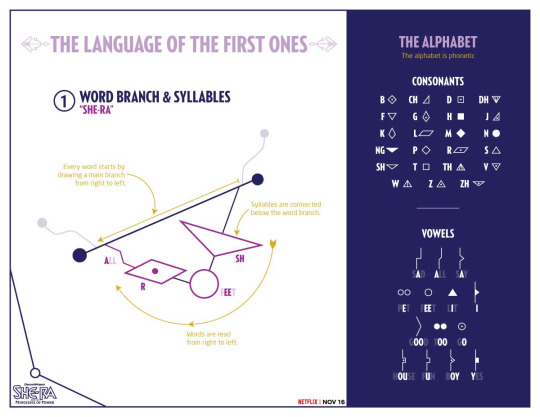
Here’s the original tweet from the She-Ra Twitter account, which has more examples: twitter. com /dreamworksshera/status/1055474341553623040
Here we go! Putting it under a break so it doesn't eat up your whole screen.
THE SOUNDS OF ENGLISH & THE IPA
So first of all, we need to start with a brief introduction to the IPA. (If you’re already familiar, you can skip to the next big heading.) Lots of languages use a lot of different letters or other characters to represent certain sounds, but when you're working with linguistics, you need to be able to say exactly what you mean. So, we made the International Phonetic Alphabet. This is a long list of individual letters and markings that represent very specific sounds, and you use them by placing them between slashes, like /d/, and sometimes to distinguish, you place the actual writing between corner brackets, like <d>. So for instance, /t/ and /h/ make the same sounds that <t> and <h> make in English, but <th> (usually) makes either the /θ/ or /ð/ sounds. These change based on where you live, but in general the consonants are the same for all English speakers.
Knowing this is important, because something I love about the First Ones alphabet is that it isn't just a letter substitution! Many "secret language" alphabets I've seen in kid's series (like Artemis Fowl, for instance) are just simple one-to-one substitutions for the Latin alphabet we use. But First Ones writing is actually very different! It uses the actual sounds made in the word. So if you wrote "cat" in the First Ones script (which I'm gonna call Eternian, after Eternia from He-Man, which flows better than "First Ones script"), it would actually look like "kat", because the letter c can be used for the sounds k or s, so it doesn't translate.
The alphabet we're using right now was created for the Latin language, derived from the Greek alphabet, which itself has a very long history behind it. English is NOT descended from Latin - it's a Germanic language, and the Germanic family is only kind of related to the Romantic family that developed out of Latin. However, a lot of our vocabulary has a Latin infusion because of mixing with Old French in the 1000s-1100s, and even before that, we used the Latin alphabet because it was the most common. This means that in order to express all the sounds we have, English speakers writing English had to combine different letters together; this, plus over a thousand years of different spellings and dialects, means that our orthography - our way of writing the sounds we say - is FUCKED. The Eternian alphabet is actually a much more efficient way of writing these sounds!
This is the total list of English consonants:
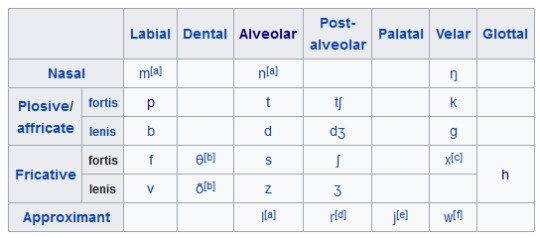
A few notes here:
To make sure you're not lost, /ŋ/ is <ng>, /j/ is <y>, /θ/ and /ð/ are <th>, /ʃ/ and /ʒ/ are <sh> and <zh> (the French <j>, not usually distinguished in English writing) respectively, and /tʃ/ and /dʒ/ are <ch> and the English <j> respectively.
Most consonants can come in voiced and unvoiced versions (although, because English is weird, these are called "fortis" and "lensis" because we pronounce them with different amounts of energy). /b/ is /p/, but pronounced using the vocal chords. Only the nasal sounds, the "approximants", and /h/ don't have pairs in English, although /h/ DOES actually have a common voiced pair, and you can technically pronounce the others voiceless in some languages although it's very rare.
The /x/ sound, famously the end of the Scottish word "loch", is only found in Celtic accents (Scottish, Irish, Welsh) and in the South African accent (because of influence from Dutch). Other English speakers realize it as /k/.
The /r/ sound is weird. What /r/ technically represents is a trill, like in the Spanish <rr>. However, in English, that trill is very rare; what we use <r> for is called a "postalveolar approximant", [ɹ̠]. However, it is usually easier just to write the letter r, so that's how we transcribe it for English's IPA.
English also sometimes has what are called "syllabic consonants", which are consonants that can act as the center of a syllable in the place of a vowel. In English, these are mostly /l/, /m/, and /n/. For instance, the word "bottle" is technically pronounced [ˈbɑɾl̩] in General American English, and the same goes for words like "rhythm" and "button"; however, because this would complicate things a lot, phonologists consider it to include a very small vowel, so with the example of "bottle", it would be /ˈbɑtəl/ instead.
The vowels are a bit more weird than the consonants. Our alphabet was originally created for Latin, which only has ten vowel sounds, long and short a, e, i, o, and u (although technically the short vowels are /a ɛ ɪ ɔ ʊ/ instead of /a e i o u/, because fuck it I guess). However, we have a MUCH different vowel "inventory" in English - instead of the uniform 10 paired Latin vowels, in General American English we have anywhere from 11-13 vowels depending on your interpretation along with three diphthongs (combinations of two vowels used as a single vowel):
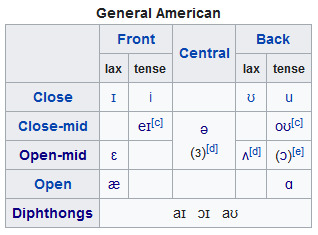
If you look at the British (Received Pronunciation) chart it's much different from that, which is why the accents are so distinct; however, Eternian is made with GA English in mind, so I'm just going to focus on that.
More notes:
/ə/ (a schwa, like in "uh"), /ɜ/ (very similar and hard to distinguish in writing), and /ʌ/ (something between an "uh" and an "ah"), are all very close to each other and sometimes interchangeable, especially between the first two.
/oʊ/ is usually simplified to /o/, and /eɪ/ is sometimes simplified to /e/, since the normal versions of those sounds don't show up so we don't have to make the difference clear.
A lot of accents in North America make /ɔ/ sounds (similar to "aw" or "au", like in "caught") into /ɑ/ sounds (the o in "hot").
Now, let's move on to the alphabet!
ETERNIAN GLYPHS & SIGILS
The "letters" of the Eternian alphabet, in my opinion, are better described using the more general term "glyph". This is because, while they are distinct shapes that mean specific sounds, they are used kind of artistically and variably within one large interconnected word-shape called a "sigil", much different than we would consider letters in the English alphabet. These glyphs are organized in words by lines starting at the basic shape of the sigil and stringing them together in order.
Eternian glyphs are split into two major categories that differ by shape: consonants and vowels.
CONSONANTS
The system of glyphs for Eternian consonants is actually very easy to remember, once you get the shapes down! Let's go back to the voiced/voiceless pairs. English has eight pairs of these, four plosives (made by quickly starting and stopping air with your mouth) and four fricatives (made by constantly moving air through your mouth). These eight pairs - along with another pair for /r/ and /l/ even though they aren't voiced/voiceless, because they're also closely related - make up most of the sounds in English and most of the consonant glyphs in Eternian. In each of these pairs, the voiceless (and /l/) have a basic, empty polygon shape; the voiced pair (and /r/) use the exact same shape, but with a dot in the middle. Like so:
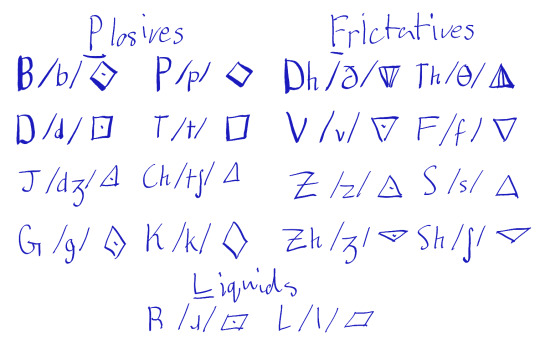
Outside of this, English has four more vowels - /m/, /n/, /ŋ/, and /h/ - and two "semivowels", which can be used either as a vowel or a consonant. One of these semivowels, /j/ (the English y), is used as a vowel in Eternian, while the other, /w/, is treated as a consonant. Except for /w/, these remaining consonants are all marked by the fact that they’re solid color; they also all use the same basic shapes as many of the others, but aren’t related to the sounds which share their shape:
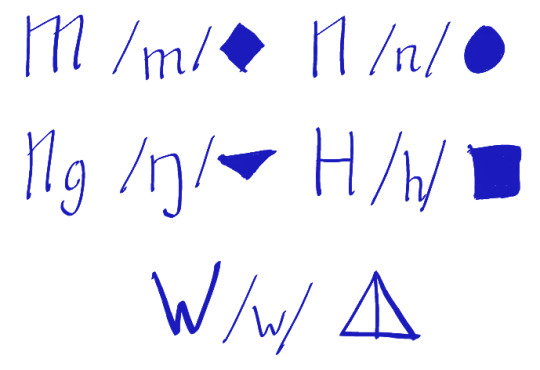
Pretty simple once you get the hang of it! Excuse the messiness; if you want a more precise rendering, you can reference the original release at the top.
I'm pretty sure this is all accurate, but there's one thing that seems weird to me. In English, <th> can be used to express either voiceless /θ/ or voiced /ð/. However, in Eternian, they gave us a "dh" glyph. I assume that this is meant to represent /ð/. However, in Wrong Hordak's "Smooch The Chef" apron, "the" is spelled with the glyph used for /θ/. But honestly I'm just assuming human error on that one, especially because /ð/ is very rare at the beginning of words except for articles or pronouns like the and these, most cases of <th> at the beginning of a word are /θ/ like in "thorn".
Now, for vowels!
VOWELS
Like I said earlier, this bit is much more complicated to get than the consonants, but luckily, this is actually much better for English than Latin letters!
Eternian vowel glyphs are divided, seemingly at random, into two subsets with a single exception. First are line-glyphs, which are formed by altering the connective line between two geometric glyphs. The others are circle-glyphs, the ones used for /ɛ/, /i/, /u/, and /o/. These function in the exact same way as the consonant glyphs, except that they are all circles where none of the consonants (except /n/) are.
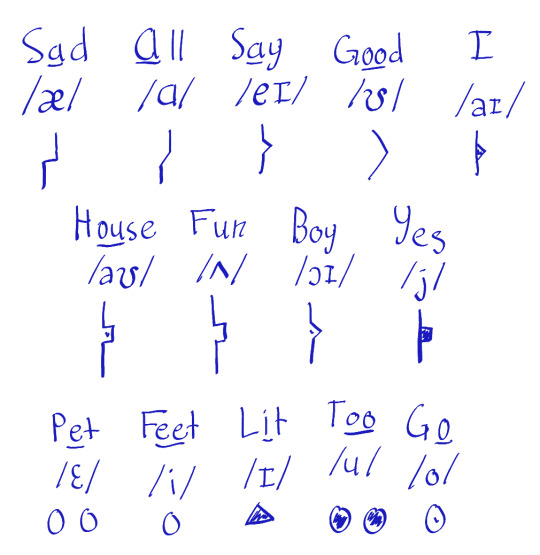
There's a few issues here with transcribing words, but they mostly come out of simplifying English's horrible vowel fluidity. For instance, there's no distinct letter for writing the schwa /ə/, but it can be folded into the letter for /ʌ/. That, and combining /ɔ/ with /ɑ/, simplify 16 sounds into 13 letters. The last letter, /j/, is the other semivowel I mentioned above; <y> in English can be used for either /j/ or /aɪ/ and /ɪ/, but this letter specifically represents the /j/ sound like in "yes" or "yak".
BRINGING IT TOGETHER
This is where things get very interesting. Let's start with the basics, walking through how to write the word "Adora".
Eternian, as a writing system, is much more artistic by design than Latin, and words and sentences can be constructed in many ways which are all read the same way. Eternian words - better called "sigils" - are read right-to-left, like Hebrew, Arabic, or traditional Japanese and Chinese. We form the sigils starting with a line sloping down in that direction book-ended with dots. The exact angle and length doesn't matter, but the right side is always noticeably higher than the left, like this:
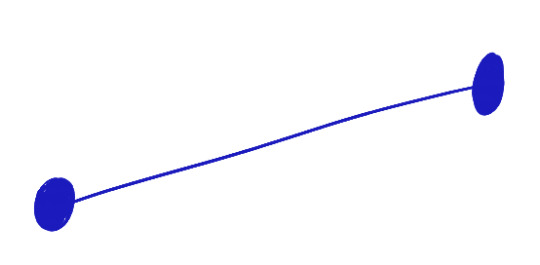
We then add two additional decorative lines built off of that base, which end in dots:
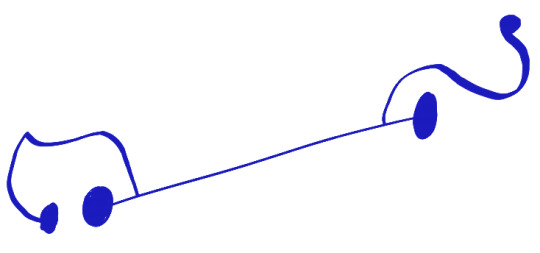
These flourishes can be curved, geometric, or a mix of both, and often inform a lot about the "personality" of both a sigil and its writer, and can distinguish one sigil from another. They're like the sigil's signature. They can be any shape or length, but never overlap with themselves or other lines.
The next step is to begin adding the sounds. Much like the flourishes, these are constructed differently for every sigil, although again they are all read from right-to-left and the symbols are placed with that in mind. These are strung down from the sigil's base, connecting with straight lines. Let's start by placing the a-sound in "Adora" near the right-side edge of the line (this is the /ʌ/ line-glyph, like the u in "fun"):
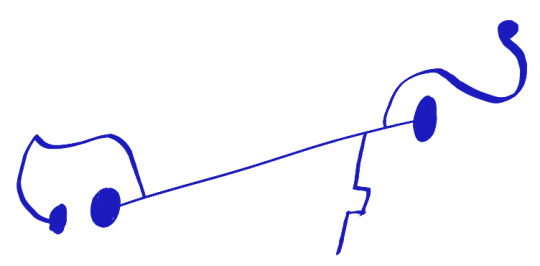
Because the /ʌ/ glyph is a line, it replaces the normal connecting line. Let's finish this syllable line with the /d/ glyph:
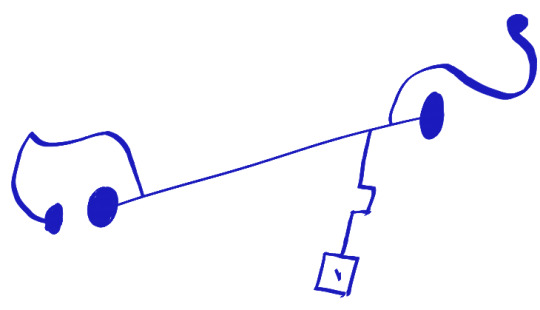
...and then add another line with the glyphs for /orʌ/:
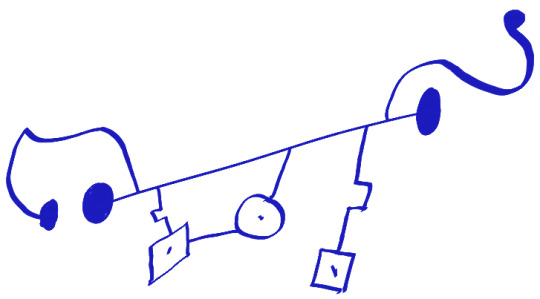
Generally, when a cluster ends with a line-glyph, it connects back to the base line. Clusters not at the end cannot end on a line-glyph (though I'm not sure about what to do for line-glyph-only words like "I" or "a" - perhaps the base line is changed, the line curves in an arc, or it ends at the changed portion?). Additionally, line-glyphs are always turned in the direction they're going - the beginning and ending /ʌ/ glyphs are flipped from each other, because the ending glyph is turned upwards going towards the base line while the beginning is stemming from it.
The important thing to remember is that sigils can be formed in a variety of ways - the flourishes, line angles, how you structure the syllables, all of these are dependent on the writer, so long as they follow those general rules. I constructed that sigil “AD.ORA”, but it could just as easily be “ADO.RA”, and in larger words there’s much more potential for structural changes.
Sigils in a sentence are connected through lines which meet the word next to each of the flourishes, and which bend to fit the shape of the sentence. Sentences are not read in any specific direction, but words are clustered in aesthetically pleasing ways and sentence order is shown by these connecting lines. However, The initial word in a sentence only has a line connecting on its left side, the final word only has a line on its right side, and words in between connect to the previous word on their right and the next word on their left.
Let's try extending this to a simple sentence - "Adora is She-Ra." We already have the She-Ra sigil from canon, so we just need to connect them with the word "is".
First, let's write the next word, below and to the left:
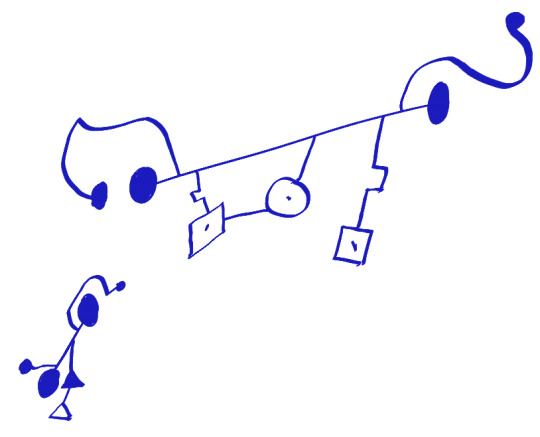
And connect the two with a line:
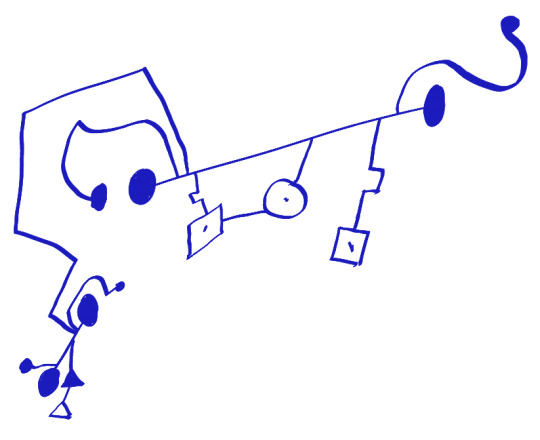
And then repeat with the "She-Ra" sigil.
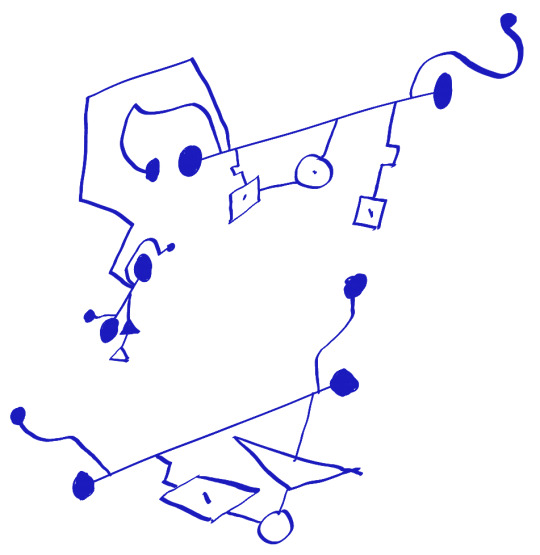
...and finally...
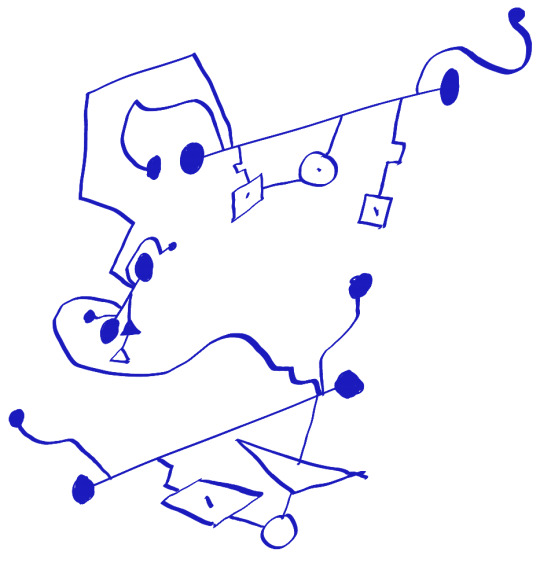
There we go! You've officially written a sentence using Eternian glyphs! I hope you have fun with it! If you have any questions feel free to shoot me an ask. Thanks for reading!
231 notes
·
View notes
Text
Yuletide letter
I am laughingpineapple on AO3
Hello dear author! I hope you’ll have fun with our match. Feel free to draw from general or fandom-specific likes, past letters, and/or follow your heart.
Likes: worldbuilding, slice of life (especially if the event the fic focuses on is made up but canon-specific), missing moments, 5+1 and similar formats, bonding and emotional support/intimacy, physical intimacy, lingering touches, loyalty, casefic, surrealism, magical realism, established relationships, future fic (when in doubt, tell me what’s happening to them five, ten, twenty years in the future!), hurt/comfort, throwing characters into non-canon environments, banter, functional relationships between dysfunctional individuals, unexplained mysteries, bittersweet moods, journal/epistolary fic, dreams and memories and identities, tropey plots that are already close enough to characters/canon, outsider POV, UST, resolved UST, exploring the ~deep lore, leaning on the uniqueness of the canon setting/mood, found families, characters reuniting after a long and/or harrowing time, friends-to-lovers, road trips, maps, mutual pining, cuddling, wintry moods, the feeling of flannel and other fabrics, ridiculous concepts played entirely straight, sensory details, places being haunted, people being haunted, the mystery of the woods, small hopes in bleak worlds, electricity, places that don’t quite add up, mismatched memories, caves and deep places, distant city lights at night, emphasis on non-human traits of non-human characters (gen-wise, but also a hearty yes xeno for applicable ships), emphasis on inhuman traits of characters who were human once and have sort of shed it all behind
Cool with: any tense, any pov, any rating, plotty, not plotty, IF, unrequested characters popping up.
DNW: non-canonical rape, non-canonical children, focus on children, unrequested ships (background established canon couples are okay, mentions of parents are okay!), canon retellings, consent issues, actual covid (fantasy plagues are okay)
Les Cités Obscures: any
This is a very general “please, anything in the style of canon, just maybe with less thoughtless sexism” request. I want to lose myself in these cities again, and in the strange lands that connect them. I’d be happy to follow any of the known characters and/or OCs, or eschew characters altogether and write about the cities themselves. What caught your imagination in Brüsel, Xhystos, Taxandria, Alaxis...? The history of some cool building that was only marginally featured in one of the stories? Or an OC city! If you’ve got a favourite European city that doesn’t already have its obscure counterpart, please tell me all about it! Go big, go wild! What strange and classically surrealist happenings take place within its walls? Or even... outside Europe... Nerding out about architecture is of course very welcome. I would also love to read a story based on any Schuiten illustration, contextualizing it as if it were part of this ‘verse. Here’s a bunch of them, for example!
Ghost Trick: Cabanela
You know.. him. Dazzlingly OTT, untiring, rock-solid self-esteem, loyal to a fault, following a rhythm of his own, flawless intuition until it fails and it all burns down… him. I just want to see more of him doing stuff! The way he’s chill and open toward new people (like Sissel and Missile in ch15) makes him perfect to throw at most other characters and see how they react to the sparkles… I’d love some focus on how ridiculous his aesthetic is, half Saturday Night Fever half hardboiled detective half bubbly preteen (for a total of 150%) and yet he makes it work. Or how ruthless he can be, possibly for the sake of the people he cares for. The quote “The intimacy of big parties”. Him and Alma in the new timeline bonding over knowing (once Jowd has spilled the beans) but not remembering that terrible timeline. Some tropey scenario on the job. Snark-offs with Pigeon Man, by which I mean PM snarks and it bounces off him like water off a spotless white goose’s back.
Ship-wise it’s only Cabanela/Jowd whenever it’s not infidelity, Cabanela/Alma in what-ifs also if it’s not infidelity and Cabanela/Alma/Jowd for me (and Lynne/Memry and Yomiel/fianSissel on the side). There are a bunch of shippy prompts in all my past letters - I would however reiterate here that Jowd. is. the worst tease. always. Like, just saying, but assume he’s pining big time and Jowd and Alma figure it out - they’d make a national sport out of excruciatingly protracted teasing.
Conversely, Cabanela/Lynne and Cabanela/Yomiel are NOTPs especially from Cabanela’s side. So while I appreciate the thick tension of a good Yomiel VS Cabanela confrontation like everyone and their cat, and also really appreciate a roughed-up Cabanela, and I do love Yomiel in his own right… I don’t want Cabanela being into it. Adrenaline junkie he may be but this hurts and his coat’s a mess and there’s no perfect winning scenario so he hates every second of it. (JOWD being super into Cabanela being roughed up is another matter altogether and he should probably mind his own business. ...incompatible kinks, truly tragic. they’ll have to find some other common ground. they’re smart, resourceful, playful fellows, I’m sure they’ll manage)
Kentucky Route Zero: Donald kentuckyroutezero
I love everyone in the cast, all acts and interludes, and I am extremely into all the themes this incredible work of art ended up exploring. Agreeing with the overall doom and gloom up to Act IV, I was blown away by Act V’s strong affirmation of the importance of the arts and of the bonds we make and of carving up spaces for ourselves in capitalism’s wake. Donald was, indeed, not a part of any of that. Even the final interlude updates us on Lula and mentions Joseph, but the big guy is nowhere to be seen. So, you know, there’s fanfiction! He’s so static, defeated. I am fascinated by the chain of metaphysical spaces that goes surface -> Zero -> Echo -> Dogwood and even within that framework, the hall of the mountain king is like a hopeless dead end. Dude’s terminally stuck. So - once again, in the spirit of transformative works, how could he get... you know... unstuck? Did Lula’s momentous appearance in Act III shake him? Having a functioning Xanadu again, perhaps? How could he interrogate that oracle, what recursive wonders would it show him? If he decides to leave, what does it feel to be on the surface again after so long, or on the river perhaps? Maybe he is forced to leave by the flood, if not this one, the next... Having him meet any other character would be amazing. Past or future time spent with Weaver... seeing Conway again, changed... programmer guy chatting up musician androids... did he know Carrington from his college days or was Carrington only a friend of Lula’s?
As for Lula herself and Joseph too: “Flipping through the pages, Conway is able to gather that it’s a story about three characters: Joseph, Donald, and Lula. It’s something like a tragic love triangle, but much more complex. Some kind of tangled, painfully concave love polygon.” 😔 I ship them as a full triad, if you can nudge them in that direction, good. But I’m very open to non-romantic resolutions as well, going past their messy feelings to find each other as friends after so many years maybe. Or... a start. idk.
I’d be interested in fic that leans on the game’s adjacent genres: wanna go full-on American Gothic? Dip into surrealism? Take a leaf from Twin Peaks with tulpa / split narratives to explore the characters’ issues? I’m also open to AUs, real or through Xanadu. This also feels like a good place to stress that I really, really like caves.
And now for something completely different: FAQ: The “Snake Fight” Portion of Your Thesis Defense is in the tagset this year. I’d say that the crossover with the snake portion of Here and there along the Echo writes itself, but it would not be correct, as in fact I would like you to write it for me. Feel free to not feature Donald if you focus on this crossover instead!
Uru would be a fun crossover too, for Donald specifically. He’s very DRC-shaped in how he tilts at doomed projects which just so happen to be deep underground.
Pyre: Volfred Sandalwood
This is a Volfred solo, Volfred&literally anyone or Volfred/Tariq, /Oralech or /Tariq/Oralech request. I adore everyone in that Blackwagon+Dalbert+Celeste, so if you want to add a Nightwing or two to any prompt, please do! I also love all the Scribes and find Erisa a compelling tragic figure, while out of the other triumvirates, I’m “love to hate them” for Manley, Brighton, Udmildhe and Deluge and would not like to see them featured in sympathetic roles. fwiw I also enjoy Jodi/Celeste and Bertrude/Pamitha a lot!
I feel deeply for all of Pyre’s main themes - literacy, degrees of freedom, the fragile time that is the end of a historical cycle, nobodies rising up to the occasion, building a better society, and of course found family, “distance cannot separate our spirits” and all that jazz, and Volfred is squarely rooted at the center of all of them. I really really love everything he stands for, even if he’s overbearingly smug in standing for it. Just please tell me things about my fave. His relationship to the Scribes (as a historian, a some kind of vision, via *ae or once he’s a star himself)? A ‘forced vacay’ Downside ending where he looks at the Union from afar and keeps living in this strange transformational place? Life in a cramped Blackwagon that was meant for like 5 people tops and is currently eight Nightwings, a herald and an orb? Since he picked him for the job to begin with, does he respect and cherish Hedwyn as he dang well should? What does it feel like to try and Read a herald? Was he ever in danger, in the Commonwealth or in the Downside? What daring act of resistance did he and Bertrude pull off at some point in their past? It’d be cool if one of his old pamphlets came up at some point. Does he puff up as prime minister because he’s nervous, and who can see past his hyper-professionalism and lend a hand? Please roast him big time about the votes he assigns to the various Nightwings in his planner? What’s his attitude toward the flame’s purification (what with being a tree but mostly like, as a general concept. He did nothing wrong!) (well he definitely said some things wrong and sometimes oftentimes the ego jumps out, but his intentions did nothing wrong)? When did his calculating approach fail him? Something with Pamitha along the lines of that edit that goes “Can we talk, one ten to another?“/"I am an eleven, my girl, but continue”? Dude could easily be voted sexiest voice in the Downside - how much is he aware of it? Does he sing? I love how he bears his ‘reader’ brand proudly. And speaking of scars, I have to wonder, looking at Manley for comparison, if the shape of his head, with that massive crack, isn’t also due to injuries.
As a refrain from my general likes: emphatically yes xeno to both shippy interactions at all ratings and to gen explorations of what a Sap is like… I’d love to read all your headcanons.
Ship-wise, I enjoy him with Tariq as this kind of esoteric connection of minds, guarded words full of secret meanings, long contemplative walks together (is any external pov watching...?), Volfred’s Reader powers brushing against Tariq’s mind and getting weak in the knees at the starlit expanse he finds there, so unlike mortal thoughts. Tariq finds his individuality learning from him; Volfred presumably gets a transcendent glimpse of the Scribes. And I enjoy him with Oralech as pretty much the opposite of that, Oralech is so very mortal compared to him, such a precious, fleeting, burning life especially after his fall. Oralech’s idealism is very dear to me, it was their plan, their shared revolutionary spirit, I find it deeply moving. And I am very interested in seeing them rebuild their connection now that Oralech is back, changed, and in some ways he can learn to let go of his misconceptions and slowly open himself to Volfred’s love again, but in other ways that’s who he is now, with this deep-set anger, and what does it even feel to realize that you’re the symbol of the end of an era (the end of the Rites, the fading of the Scribes). I’m interested in both topside and downside endings for all of them, as long as they end up on the same side, the revolution was peaceful and they don’t angst too much about the side they ended in. Tariq can ‘find his way home’ in the near post-canon somehow or even be summoned again, as a different aspect of the same ‘moonlit vision’ that once inspired Soliam Murr.
Strandbeest: any
https://www.strandbeest.com/
I would just like words to go with these, please and thank you so very much. Worldbuild to your heart’s content! Specifically: I’m fascinated by the premise that the strandbeest are living creatures that evolve and adapt to their ecosystem. A world where life is just wind stomachs and sandy joints, and the tide that can catch you unaware. I would like a story that feels distinctly inorganic. The wonder that is the existence of these creatures. Their unique struggles. Weird and experimental if you like. With a mechanical focus, maybe?
I nominated four critters as a selection of the different cool things they can do - Percipiere Excelsus is huge and has the hammer mechanism, Suspendisse’s tail senses the hardness of the sand, Uminami is my fave caterpillar and the caterpillars overall feel like a new paradigm after a mass extinction event, Ader straight-up flies... but they’re all wonderful. If you want to focus on different strandbeest, please do!
Twin Peaks: Lucy Moran
Case fic but they don’t find out jack shit, someone disappears, David Bowie was there, it’s complicated. Fragmented, shifted, mirrored identities. New Lodge spaces. The risks of staring into the void for too long. Gentle illusions. Transcendence. The moon. Static buzzing. Any title from the s3 ethereal whooshing compilation used as a prompt, actually. Whatever goes on on Blue Pine mountain or the even more mysterious things that go on on White Tail mountain where exactly zero canon locations are found. Twin Peaks is all about the mystery to me, the awe of mystery and unknowability and the human drive to look beyond and the risks of getting a peek, and about shared consciousness and trauma taking physical form in an uncaring world. Go wild with the ethereal whooshing! But I also love the human warmth at the heart of it all, and sometimes it’s enough to anchor these characters and let them have a nice day. A fic entirely focused on some instance of coziness against the cold chaotic background of canon would be great too.
For Lucy specifically, a big draw for me is how canon (...s2 need not apply) empathizes with her way of processing the world. Not just Peaks, but On the Air’s protag who is basically a Lucy expy also gets the narrative completely on her side and that’s great. And I love how in s3, her focus on the small things around her is always echoed by bigger, climactic events beyond her horizon (bunnies / Jack Rabbit’s palace, chair order / Garland’s chair, her first scene talking about the two sheriffs / doubles everywhere...). It feels to me like some kind of off-kilter mindfulness and I love it. She’s also got a loving husband and an amazing son, which, in this economy and also this canon? Damn. The one functional family, imagine that. I am not interested in focus on family dynamics, but singularly, either Lucy/Andy or Lucy&Wally are great - in particular, I’m interested in how strange they are and yet they make it work. With the ruthless critique of traditional family structure that’s all over canon, maybe they make it work specifically because they’re not doing any of that. A bit like the Addams family... but... not goth...? Anyway. I’d love to see Lucy interact with and maybe strike a friendship with any character she’s never shared a scene with in canon! In the tagset, there’s Diane for some secretaries bonding, Audrey because??? why not?, Albert because it’d be an epic enemies to friends slowburn, some version of Laura in the future, if we’re feeling really daring maybe even some version of Coop in the future, still fragmented... or anyone you want! Outside the tagset I’d be curious about Hawk, Margaret and maybe Doris in particular, I think, and Phil, and Nadine and the Invitation to Love fandom in general (Frost says it still airs - did it get as weird as TP s3 did?), but if you have an idea with someone else, absolutely go for it!
Canon-specific DNWs: any singular Dreamer being the ‘source’ of canon, BOB (let alone Judy) being forever defeated in the finale, Judy being an active malevolent presence in the characters’ lives, clear explanations for canonical ambiguities, ‘Odessaverse’ being the reality layer, the Fireman’s House by the Sea being the White Lodge, whatever Twin Perfect’s on about, Cooper/Audrey, Cooper/Laura
2 notes
·
View notes
Video
vimeo
Miguel CHEVALIER Complex Meshes 2017 (Long version), Jacksonville Florida (USA) from Claude Mossessian on Vimeo.
A film by Claude Mossessian © Claude Mossessian
Miguel CHEVALIER Complex Meshes 2017
FOR TECHISM EXHIBITION Installation de réalité virtuelle générative et interactive
ARTREPUBLIC, 100 N. Laura Street, Jacksonville, USA
Logiciel : Cyrille Henry / Antoine Villeret
Production technique : Voxels Productions
Artists: Miguel Chevalier, Fabian Forban, Krista Kim, REO.
Date et heure du vernissage : Du 3 au 12 novembre 2017
artrepublicglobal.com
"Complex Meshes" is a monumental projection that plunge visitors in an universe of networks. A mesh is a three-dimensional object consisting of vertices, edges and faces which form polygons, used in 3D modeling or architecture. For this piece, the use of numerous wireframe meshes becomes an aesthetic in itself. Different colored weaving patterns composed of polygons overlap, evolve and transform slowly in real time. This huge virtual light curtain twists, moves and resizes to create diverse and complex shapes. This work is interactive. When the viewer moves in the space, the networks are disrupted.
Within this vital flow, everything floats about, branches out, always turning into something else through the interweaving of multiple lines of colored light, layered networks, and varied pathways. Elements are attracted and repelled by one another, creating a breathing-like rhythm of dilation and contraction.
Miguel Chevalier reapproaches notions of flux and networks, which are inherently difficult to perceive, yet appear here with real substance. Light, movement and energy represent some of the new poetics of matter which emerge from the continuation of kinetic art.
This dynamic work reflects with poetry, flux of data and informations, exchanged in real time in our world today, which weave throughout our environment and circulate continuously at an ever-increasing speed.
0 notes
Text
Sfz Vst Plugin Download

Vst Plugin Download Free
Vst Plugin Download Audacity
Sfz Vst Plugin Download Windows 7
Vst Sfz 64 Bit
Sfz Vst Plugin Download Windows 10
Sfz Vst Plugin Download Chrome
For any modern producer, a sampler is essential. However, if you’re strapped for cash or just starting out, it can be difficult to find good-quality sampler plugins that actually work and add to your beats.

Native Instruments. Native Instruments has done a remarkable job by releasing KOMPLETE. SFZ+ Professional. Rgc:audio’s revolutionary SoundFont player sample-playback engine, packed in a professional VST/DXi instrument. Outstanding sound quality, stereo built-in effects, adjustable CPU/quality settings to adjust it to your hardware, fully multitimbral operation, multiple stereo outputs, several loading modes including direct-from-disk streaming and a beautiful interface make. Slinky Violin comes in three versions: Kontakt 5.8.1 or later (full version), SFZ (tested with free Plogue Sforzando), and Decent Sampler proprietary sampler plugin (freeware). In order to download this library for free, a valid email address is required. Jan 04, 2021 Indian instrument VSTs are quite hard to come by, especially the free ones This is why I put together this list of the 8 best free ones I could find. Let’s get straight to it Acoustic Indian Dhol Lite by RDG Audio Available for Windows and Mac. Acoustic Dhol is a sample based Indian Dhol Instrument. It has been 10 Best Free Indian Instruments VST/AU Plugins Read More ».
Luckily, we’ve cut through the weeds and compiled 9 of the best free sampler VST plugins out on the market today.
Free Sampler VSTs
Without delay, here are our top picks. Sit back, relax, and explore these excellent samplers.
Grace Sampler by One Small Clue
The Grace Sampler is simple, sleek, and suited to synth users. The sampler has optional patches free for download on its website, most of which are for synths, but there’s also a couple for drum kits, keys, and bass.
This sampler comes in both 32 and 64-bit versions, so you won’t have to worry about compatibility from device to device. With most DAWS, you can drag and drop your samples right into the sampler, simplifying your workflow.
Grace Sampler comes with 2 step sequencers, 2 LFOS, and 4 different control pads. The sampler supports WAV, AIF, and SND formats directly which is impressive for a free plugin.
Grooove by BPB
If you’re looking to create some vibey drums, Grooove by BPB is a great pick. This drum sampler is perfect for techno and EDM musicians, looking to create catchy, unique loops.
The plugin has different slots in which 2 different drum samples can be layered and played simultaneously. The slots all have built-in LFOs for altering filter cutoff, sample delay, pitch, and standard attack, volume, pan, and start/end times. Luckily, the VST is supported in both 32 and 64-bit versions.
Grooove BPB is the free version of a full-on instrument, so if you like the notable sampling capabilities that come with the free VST, the purchased version by brunsandpork is a great step up.
TX16W Software Sampler
The TX16W software sampler has a wide array of features that usually only come with paid plugins. With this sampler, you can record samples directly and edit keyboard mappings making it a great pick for musicians looking to incorporate their DAWs into live performance.
Vst Plugin Download Free
As for modulation, the sampler has 2 LFOs and 3 step sequencers. Velocity and mapping can be handled by drawing a custom curve or using the integrated knobs. The plugin also acts as a bus so you can send in and out effects in real-time.
TX16W has 64-bit support and has a built-in arpeggiator, for a paid add-on, you can have time-stretch and pitch-bend modes. For free or otherwise, this plugin is no joke.
Sforzando by Plogue
Sforzando prides itself on its simplicity, with no graphic visualizer. There’s only one sample slot, with no effects or mixers.
The plugin simply consists of standard ADSR knobs, volume, pan, tone, and tune controls. Although this may feel limiting, for seasoned producers looking for a specific sound that doesn’t need a whole lot of extra fluff, Sforzando can be extremely helpful.
If anything else, the plugin works as a great ear-training tool and can train musicians to rely on their skillset rather than software. It comes with 64-bit support.
Zampler by Plugin Boutique
Zampler by Plugin Boutique is an excellent add-on for electronic musicians as you can download drum & bass, hip hop, even dubstep expansion packs.
The sampler has 3 LFOs and a large effects library including chorus, phaser, tube saturation, and many more. There are 2 sample banks and 3 ADSR envelopes for full modulation control.
Zampler has a step sequencer as well as sample oscillators for you to further tweak your sound. Unfortunately, Mac users only have 32-bit support. Windows has both 32 and 64-bit support, but any sample formats outside of sfz must be converted.
Paraphrasis by VirtualAnalogy
Paraphrasis helps you create those retro analog tones with any sample. Simply place your sample into the Paraphrasis sampler, and the modeling synthesizer will analyze the sound data to produce a more classic sound. This VST is pretty simple, and the UI reflects that; there’s simply a pitch, resolution, analyze, and source toggle with no extra bells or whistles. There’s only one slot to the plugin, but on the upside, it doesn’t take up a large amount of CPU.
There’s also a handy reverse toggle, so you can reverse your sample before giving it that added analog touch. Some users had trouble using this plugin in 64-bit though it supports both versions, so make sure you’re downloading the proper .dll when acquiring this plugin.
XTT01 by Synthedit Labo Japan
The XTT01 has that classic rack-mount feel and is designed to give you a sound reminiscent of the past. This sampler is known for its signature glide function.
This VST is pretty bare bones. There are the standard ADSR knobs to toggle the filter and amp envelopes, and a built-in LFO with speed, PW, and depth knobs. You can also pitch shift by semitones within the sampler.

XTT01 has no visualizer, so it’s a great tool to use for musicians who are more auditory based learners. You can only load one sample at a time in this plugin. Unfortunately, this simple yet powerful sampler only supports 32-bit software, so it may not work for you if you have more modern equipment.
Bassje by Odosynths
Bassje by Odosynths is a great drum sequencer to give your beats the funky groove they’ve been missing. It’s loaded with 3 different toms as well, so if you’re just looking for a great tom loop generator, Bassje is a great addition to your library.
The plugin is separated into two main sections: An octave and filter sequencer. Nothing can describe the sounds you can get out of this puppy other than using is. Bassje has a volume, reso, and volume knob.
Its retro UI speaks to the nature of the plugin, as it’ll generate patterns very reminiscent of physical drum machines. For any musician trying to create retro-inspired music, Bassje is perfect.
Vst Plugin Download Audacity
Helios by TobyBear
Helios is an impressive audio sampler unit that is meant to be used during live performance. It has 8 different LFOs, including 2 that sync up to the sample’s tempo.
This plugin is able to tweak a sample is real-time with pitch-bending, looping, delays, and LFO filters. You can drag and drop wave files directly into the interface, making it ideal for DJs or musicians who have to improvise often. Unfortunately, it only supports a 32-bit connection so newer equipment may not work with this plugin.
What We Recommend
Any of these VSTs are excellent to try out but there are two that stand out in our minds:
Sfz Vst Plugin Download Windows 7
Grooove BPB
Grooove BPB stands out in its flexibility and abundance of features for a free plugin. With 6 different drum slots and a variety of effects, it’s a versatile sampler that can act as an effect bus if nothing else.
Oftentimes rhythm is the core and soul of music production, so having a drum sampler to assist in that process is priceless (literally).
TX16Wx Software Sampler
This sampler is a full-on replacement for any stock sampler you may have, and then some. No other sampler can compare to this VST’s level of flexibility: With separate windows MIDI mapping, envelopes, modulation, arpeggiator, and samples themselves, it’s hard to believe that this plugin is free.
Another great thing about this plugin is the ability to record and drag samples directly into the interface. This may seem like a small factor, but for the right producer, it can significantly simplify your workflow.
Paid Plugins
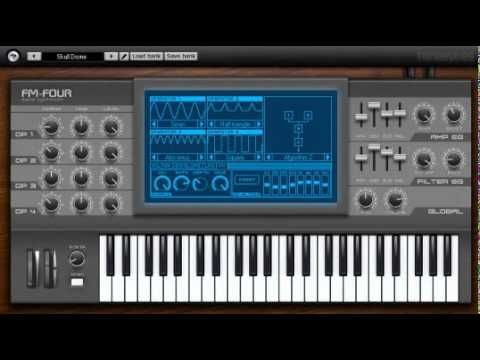
If you’ve tried out a couple of these free options and you’re looking to take the next step, be sure to check out our guide on the best-paid sampler VSTs of 2019. Here are our two standout picks from that piece.
Phalanx by Vengeance Sound
Phalanx is an impressive sampler and sound effects generator that is very versatile in use. The plugin has a number of optional expansion packs catered to specific genres of music, so you’re sure to find one that works for you.
The plugin has a polyphony threshold at 256 notes, and 32 single samples can be played at once. In addition to its bevy of embedded effects, Phalanx holds its ground when used as a drum sampler.
Read more at Best Sampler VSTs
Polygon Sampler by Glitchmachines
This sampler is relatively affordable, making it a great paid VST to consider in your transition. Although it is mainly geared towards electronic music, the unique user interface and 120 embedded presets make this a fun tool for any producer.
Vst Sfz 64 Bit
If anything else, this sampler surprisingly works well as a synthesizer with an impressive 8 LFOs. It has a lot of granular synthesis capabilities, making it a great way to boost your low-end frequencies without altering the timing of your samples.
Sfz Vst Plugin Download Windows 10
Read more at Best Sampler VSTs
***
Sfz Vst Plugin Download Chrome
All in all, any of these options are great to test out considering there’s no upfront cost other than your time. Have creating exciting new beats using your free Sampler VSTs!

0 notes
Text
En 2000, Akira Nagai (senior managing director) estime que les salles d’arcade doivent être modifiées pour devenir des espaces de loisirs plus grand public afin de toucher une cible plus large et de renouveler la clientèle. Il parle d’hybrid outlets qui seraient tous reliés par fibre optique afin de connecter toutes les bornes d’arcade entre elles à travers le Japon. En 2013, SEGA ne produit plus de consoles mais s’accroche plus que jamais à l’arcade, qui est en quelque sorte dans son ADN.
Si l’on revient aux débuts de SEGA, avant même que la firme ne se nomme ainsi, on trouve des jeux mécaniques qui sont à l’origine du jeu vidéo d’arcade. Retournons au siècle dernier. À Hawaï en 1940, James Humpert et les Bromley père et fils fondent une société nommée Standard Games afin de monétiser le temps libre des soldats installés dans les bases militaires américaines. Après la Seconde Guerre mondiale, la société s’établit au Japon, occupé par les Américains qui livrent une autre guerre en Corée. Elle crée une filiale du nom de Service Games of Japan (1952) afin de souligner que le client visé est le soldat en service. Comme à leur habitude, les Japonais forment un mot valise plus court pour désigner l’entreprise : SEGA. Durant cette première partie de l’histoire de la firme, ses propriétaires américains commercialisent avant tout des machines à sous et des juke-boxes. SEGA fait de l’arcade au sens large du terme. D’ailleurs, les Japonais ne parlent pas d’arcade mais d’amusement, de divertissement.
Parallèlement, un certain David Rosen, soldat mobilisé pour la guerre de Corée, reste au Japon pour fonder une entreprise d’import de Photomatons. C’est un succès immédiat et il continue en important des jeux de tir : il s’agit de tirer sur des ours avec un fusil en plastique. Par la suite, il commercialise d’autres bornes similaires où il faut tirer sur des requins ou des raies. Comme on le voit, l’arcade est plus proche de ministands de fête foraine que des jeux vidéo.
L’origine de SEGA explique aussi pourquoi la firme a toujours tenu à innover dans le domaine de l’arcade. Après tout, entre les machines à tuer les requins avec un fusil et Virtua Cop où l’on doit recharger son arme en plastique pour tirer sur des ennemis en polygones, il n’y a que des différences technologiques, le gameplay de base étant le même. De même, l’engouement pour les Photomatons sera relayé par celui envers les Purikura (Photomaton avec images personnalisées à coller) de nos jours…
Les bandits manchots laissent leur place aux medal games. Quant aux juke-boxes, ils sont remplacés par les jeux de rythme et musicaux dont Project Diva est l’un des derniers avatars à succès (lire l’article consacré à Hatsune Miku).
De SEGA à SEGA
En 1965, SEGA et l’entreprise de Rosen fusionnent et la nouvelle entité change de stratégie : au lieu de simplement importer des machines, elle va en créer. Entre les jeux de basket, sac de sable à frapper, ou hélicoptère à manœuvrer, SEGA s’occupe vraiment de jeux mécaniques et électroniques. Son premier logo en caractères un peu gothiques témoigne de cette période durant laquelle les bornes de jeu sont l’essentiel de son activité.
Parmi les succès, on trouve Periscope en 1966, jeu d’arcade qui n’est plus vraiment un jeu électronique mais dont le succès est suffisant pour que Gulf & Western Industries, Inc. rachète SEGA au début des années soixante-dix. David Rosen, resté à la tête de SEGA, poursuit sa lancée avec des jeux d’arcade électroniques et lance les versions PC. Mais, avec la crise des années 1983-1984, l’industrie balbutiante du jeu vidéo sur ordinateur sombre. Heureusement, SEGA a toujours ses activités dans les bornes de jeux !
Le succès de Space Invaders étant mondial, SEGA se met à créer des jeux vidéo pour l’arcade et rachète son principal distributeur au Japon, Esco Trading. Son ex-dirigeant Hayao Nakayama prend alors la place de vice-président de SEGA. La société perdant de l’argent, la filiale américaine de SEGA est vendue à Bally, entreprise fabriquant des flippers. Par la suite, CSK rachète SEGA et en fait une société florissante. Le conglomérat japonais renomme la société SEGA Enterprises Ltd. lors de son rachat en 1984. Pendant qu’une partie de l’entreprise part à la conquête des salons par le biais des consoles, l’autre consolide l’expertise dans le domaine du jeu d’arcade. SEGA s’est diversifiée au fil du temps pour maîtriser toute la chaîne, de la fabrication à la salle où joue le public. Elle possède des salles d’arcade (nommées game centers au Japon), construit des machines et les jeux qui fonctionnent dessus. Bien sûr, SEGA continue d’innover dans le domaine de l’amusement et des machines à jouer avec notamment l’invention de l’UFO Catcher en 1985 : une pince mécanique contrôlée par des boutons permet d’attraper ou non des lots à gagner dans une gigantesque boîte transparente.
L’arcade est aussi le secteur où la recherche et l’innovation sont les plus essentielles : bien souvent, les nouveaux titres sortent sur les bornes d’arcade avant d’être adaptés pour les consoles. En 1990, SEGA a ainsi lancé la première borne d’arcade pouvant pivoter sur elle-même (R-360) et en 1993, elle a sorti Virtua Fighter, premier jeu de baston en 3D au monde.En se diversifiant dans le domaine de l’arcade, la firme obtient des revenus non négligeables tout en contrôlant une grande partie de ce marché. En 2000, un quart de son chiffre d’affaires provient des salles d’arcade et un autre quart des ventes de machines d’arcade ; les ventes de jeux et de consoles représentent le reste.
En 2012, dans les documents officiels de SEGA, l’arcade regroupe six catégories, dont une seule est nommée explicitement « jeux vidéo » : jeux de cartes à collectionner virtuelles, simulateurs, medal games, jeux avec lots à gagner, jeux pour enfants. Cette diversité se retrouve dans les salles d’arcade japonaises où le jeu vidéo tel qu’on le conçoit en Occident n’occupe qu’une place restreinte.
SEGAland
Afin de mieux mettre en avant ses bornes d’arcade et de capitaliser sur les différentes marques de son catalogue, SEGA a même créé différents parcs d’attractions à travers le monde pour attirer un public plus familial et créer une nouvelle dynamique de consommation dans un lieu de loisirs. Il y en a eu plusieurs sur le territoire britannique dont SEGAworld Bournemouth (1993-2007), SEGAworld London (1996-2000). En Australie, le SEGAworld de Sydney a survécu trois ans (1997-2000).
Aux États-Unis, une chaîne gérée par une joint-venture entre SEGA, Universal et Dreamworks devait permettre de regrouper jeux d’arcade, restaurants et autres boutiques dans un même centre de loisirs. Le premier du genre s’est ouvert en 1996 à Seattle. Plus récemment, SEGA a ouvert un parc d’attractions à Dubaï (2009, SEGA Republic). Ces parcs d’attractions sont d’autant plus surprenants qu’en Occident, les salles d’arcade ont pratiquement disparu du paysage urbain contrairement à ce qui se passe au Japon et dans le reste de l’Asie, où les game centers occupent même plusieurs étages d’un immeuble.
Si vous êtes de passage à Tokyo, vous pourrez visiter le parc d’attractions Joypolis à Odaiba (créé en 1996) ou vous rendre dans les différentes salles d’arcade disséminées à travers la ville. Les plus grosses, nommées SEGA CLUB ou SEGA GIGO, occupent cinq à sept étages et sont globalement arrangées de la même façon. Au rez-de-chaussée et à l’entrée, il faut attirer le chaland et l’arme la plus efficace est une suite d’UFO Catchers. Familles, couples et groupes de copines se retrouvent devant ces grandes vitrines lumineuses pleines de peluches, jouets mignons ou nourriture. Évidemment, comme dans les boîtes de nuit, il s’agit d’attirer la clientèle féminine pour que les clients masculins viennent fréquenter la salle… Ces machines à cadeaux attirent les jeunes filles, ce qui séduit les gamers de passage qui peuvent se dire que la salle est fréquentée par la gent féminine.
Aux étages les plus hauts, on trouve en général les jeux de paris (football et turf) et les medal games. Comme ce ne sont ni des jeux d’argent ni des jeux vidéo core gamers, ils attirent un public différent, dont les femmes et même les familles. Contrairement aux pachinkos (sorte de flipper japonais), qui permettent de gagner des lots ensuite échangeables contre de l’argent, ces titres n’offrent que des crédits supplémentaires pour rejouer. Néanmoins, tout est fait pour recréer une ambiance de casino avec les pièces de monnaie qui tombent en rythme et les lumières dans tous les sens lorsque l’on gagne le jackpot. Dans le cas des jeux de turf, les joueurs parient sur des chevaux qui ensuite font une course virtuelle.
Variation autour du jeu vidéo, certaines bornes permettent de jouer avec des cartes à collectionner : il suffit de poser une carte pour que le personnage apparaisse à l’écran et pour que le joueur le fasse évoluer, comme si l’on était dans un épisode du dessin animé Yu-Gi-Oh avec les monstres qui se matérialisent sur l’écran de la borne. Ce système a pour avantage de fidéliser les joueurs qui cherchent à compléter leur collection de cartes. Parmi les succès de ce genre, il y a le Sangokushi Taisen de SEGA. Ce STR est inspiré par l’histoire chinoise des trois royaumes. Le déplacement des personnages en jeu correspond à celui des cartes sur un écran spécial.
Finalement, seuls un ou deux étages sur six sont consacrés à des bornes de jeux d’arcade. En général, ceux-ci se destinent à des core gamers et les genres les plus populaires sont les mêmes qui ont du succès sur le marché des consoles : RPG, mecha, baston, rhythm. Bien sûr, même si vous êtes dans une salle d’arcade SEGA, vous pourrez trouver des jeux Namco Bandai comme les pods de Kidō Senshi Gundam : Senjō no Kizuna, simulateurs de pilotage de mecha avec écran panoramique. Le plus important est d’attirer et de faire rester les clients dans la salle, quels que soient les jeux…
SEGA ou comment innover dans l’Amusement
Depuis 2007, la crise du marché de l’arcade s’est fait sentir de manière plus intense qu’auparavant. Il faut dire que SEGA et les autres acteurs de cette industrie ont beaucoup œuvré pour diversifier le public et rénover les salles de jeu. Ainsi, la plupart d’entre elles sont reliées à Internet et les joueurs peuvent désormais affronter des adversaires à travers l’Archipel au lieu de simplement combattre une personne du même quartier. Toujours grâce à Internet, des cartes de fidélisation ont été élaborées pour que les joueurs conservent leurs scores et avancement en jeu. Enfin, SEGA et les autres constructeurs essaient de rendre les bornes plus faciles à adapter pour que des jeux différents puissent tourner sur une même machine et que les mises à jour se fassent sans trop de soucis pour les gérants de salles.
Afin de toucher un public d’enfants, SEGA a sorti en 2003 une borne à leur taille disposée dans les centres commerciaux pour les occuper pendant que les parents vaquent à d’autres occupations. Cette borne nommée Mushiking (Kōchū Ōja Mushikingu) combine à la fois jeu vidéo et jeu de cartes à collectionner tout en s’appuyant sur une pratique ancestrale des jeunes Japonais : le combat d’insectes. Il y a plus de six versions du jeu et d’autres éditeurs ont essayé de renouveler le succès en déclinant le gameplay à base de pierre-feuille-ciseau avec d’autres domaines à connotation enfantine. Plus récemment, SEGA s’est intéressée à la clientèle âgée pour renouveler son public.
En dehors de ces efforts pour toucher des catégories de joueurs différentes, SEGA cherche à constamment renouveler les contrôles des bornes. Ainsi, le joystick est remplacé par une sorte de souris géante pour BorderBreak, un jeu de tir et de mecha où il s’agit de collaborer avec d’autres pour gagner petit à petit du terrain sur l’équipe adverse.
Dans le même genre, SEGA a présenté une nouvelle borne pour les amateurs de danse en 2012 : MaiMai. Les joueurs touchent un écran tactile géant au lieu d’appuyer sur des touches mécaniques pendant qu’une caméra filme la prestation et la publie sur l’équivalent du YouTube japonais. Dans un tout autre genre, SEGA commercialise en 2012 une borne de jeu urinoir : Toylet. Avec la pression du jet d’urine, le joueur participe à divers minijeux dont l’un consiste à soulever les jupes de filles…
Dans le domaine des UFO-Catchers, SEGA cherche aussi à se renouveler pour attirer plus de public. La firme a diversifié la taille des machines et les lots à gagner sont régulièrement modifiés, mais c’était toujours globalement la même chose. En 2010, les traditionnelles commandes sont remplacées par une sorte de « balance board » dans la borne UFO Balance Catcher. Désormais, on contrôle la pince mécanique avec ses pieds et son poids. Toujours dans le but de renouveler les concepts de bornes existantes, SEGA introduit la 3D et des jets d’air pour des bornes montées sur vérin afin de faire des minivéhicules proposant de la « 4D ».
Bien sûr, tout en innovant, SEGA ferme sans cesse les salles déficitaires et peut annoncer en mars 2011 que les ventes de bornes ont pour la première fois depuis trois ans augmenté tandis que les revenus générés par les salles ont moins baissé. Cette politique permettra sans doute à la firme de maintenir son secteur consacré à l’amusement en Asie qui est son noyau historique.
Article initialement publié dans IG Magazine.
SEGA, l’autre visage de l’arcade En 2000, Akira Nagai (senior managing director) estime que les salles d’arcade doivent être modifiées pour devenir des espaces de loisirs plus grand public afin de toucher une cible plus large et de renouveler la clientèle.
0 notes
Text
Yuletide letter!
I am laughingpineapple on AO3
Likes: worldbuilding, slice of life (doubly so if the event the fic focuses on is made up but canon-specific), missing moments, 5+1 and similar formats, bonding and emotional support/intimacy, physical intimacy, lingering touches, loyalty, casefic, surrealism, magical realism, established relationships, future fic, hurt/comfort or just comfort from the ample canon hurt, throwing characters into non-canon environments, banter, functional relationships between dysfunctional individuals, unexplained mysteries, bittersweet moods, journal/epistolary fic, dreams and memories and identities, outsider POV, UST, exploration of secondary bits of canon, leaning on the uniqueness of the canon setting/mood, found families, characters reuniting after a long and/or harrowing time, friends-to-lovers, road trips, maps, mutual pining, cuddling, wintry moods, the feeling of flannel and other fabrics, ridiculous concepts played straight, sensory details, places being haunted, people being haunted, the mystery of the woods, small hopes in bleak worlds, electricity, places that don’t quite add up, mismatched memories, caves and deep places, distant city lights at night
Any tense, any pov, any rating, plotty, not plotty, IF, canon divergences, non-mundane AUs (space opera! high fantasy! new weird also), deep lore, unrequested characters popping up - please do go wild with the & combos!
Blanket crossover prompt with Untitled Goose Game: set that goose loose anywhere and ruin anyone’s day. Tariq and select Twin Peaks characters who are not Albert (Margaret, Laura...) may hope to tame and befriend the goose; anyone else better get wrecked. Capitalism may also get wrecked while Kentucky Route Zero characters popcorn.gif nearby
DNW: non-canonical rape, non-canonical children, canon retellings, unrequested ships (I listed all the ships I like for each fandom. Outside of those, I’d prefer if other canon characters weren’t shipped, unless they’re like, canon engaged/married)
Dark Souls 1: Solaire of Astora
I’m only familiar with the first game! It’s probably relevant to mention that I think that linking the fire is kind of a dumbass move, Gwyn is a jerk, Kaathe has his own agenda and there’s no winning move in this world, or at least no obvious one. And amidst all this nonsense, Solaire just shines, pure of heart and dumb of ass like the best of ‘em. I love his kindness in this cruelest of worlds and I love the sad edge he’s got even earlier on when he admits to being seen as weird.
I would enjoy a bittersweet ending for him but I realize both of his endings are deeply entrenched in his themes so it’s hard to make him steer clear of either of those. If you can figure out how to make him not link the Flame or survive the ordeal, I’m all ears! I like a sense of purpose being the thing that can stave off hollowing, and I like characters helping other characters finding that sense of purpose within themselves. Focus on scenery always welcome, and if you want to make up a location, that’s great too!
I’d be super happy with a story set during Solaire’s time in Lordran that simply doesn’t mention his endings, anyway. Maybe he’s the one who helps someone else while his own tragedy keeps looming on the horizon. Striking up friendships in the face of a crapsack world! Meeting people through Lordran’s temporal/dimensional fuckery, where it’s possible to cross the path of warriors who have been gone for ages… could Solaire meet either or both Catarina knights (there’s so much great art about sun bro and onion bro but where’s the fic?), or do the grumpy grump&ray of sunshine routine with Logan, or meet Artorias or even Gwyn before he linked the Flame - or himself? What if he met Kaathe?
Ships: none really? Solaire/Chosen Undead but I don’t really like to read about customizable protagonists in fic so I’d rather not get fic featuring the CU. I’m all about the & character combos here.
Ghost Trick: Cabanela, Jowd
I love Cabanela being fierce and dazzling bright and determined and loyal to the very end, dancing to his own rhythm, so sure of himself and of his ideas that he doesn’t even need to prove to anyone that he’s right. Too sure of the wrong idea, once, and everything crashed and burned. And I love Jowd being the immovable object to Cabanela’s unstoppable force, a suicidal trainwreck of guilt with the gallows humor to show for it, and also incredibly smart (both jerks figured out Sissel’s powers better than Sissel did, that’s... something) and athletic and with an unsuspected talent for stealth.
I am very interested in various characters finding about the erased timeline, but not getting their memories back, and having to live with being told about what they did but never remembering it. Touch-starved Jowd in the new timeline is a surefire hit (or maybe Cabanela if he’s the one who came back and kept the memories of the old timeline). Touchy-feely Cabanela as kind of his baseline with the people he likes. All what-ifs welcome:what if they managed an acceptable happy ending but didn’t reset the timeline, what if Alma’s ghost stuck around… I’m also wondering about either of them ending up undead via Temsik shard - how would they take these developments (I’m assuming better than Yomiel did but the bar is admittedly low), did Cabanela do it on purpose for whatever sensible-if-you-are-Cabanela reason, what does it change in their relationship, what are the practical pros and cons of the situation here. UFO adventures with Pigeon Man! Lynne teaming up with either of them against the other! Sissel death-averting action if either/both of them die or just regular cat action! Spy stuff! Daring rescues! My forever prompt of Jowd being the one who gets a chance to prove his loyalty to Cabanela for once. Dancing.
Please no Yomiel. Nothing against the guy I’m just getting an overdose of him through RPing.
Ships: Alma/Cabanela/Jowd and all sides thereof, but when it splits the canon couple I only like it when the missing spouse is dead or otherwise unavailable, hopefully with a reset on the horizon. If you want to go for a Cabanela&Alma or Cabanela/Alma who are strongly motivated by a dead or jailed Jowd, I’m good with him not actively appearing in the fic. Alma/Jowd & Cabanela is excellent in all scenarios. I’m good with explicitly non-romantic takes on Jowd&Cabs but please keep their bond strong, and please no conflicting ship for Cabanela. Lynne/Memry!
Kentucky Route Zero: Any (Lula Chamberlain, Joseph Wheattree, Donald kentuckyroutezero, Weaver Màrquez)
(if enough of us request it, will some Murphy corollary guarantee that Act V will come out between now and reveals just to mess with the Yuletide schedule? If it does, I’ll be playing it immediately and probably add a few thoughts and prompts here for kicks, at the end of this section, after a spoiler warning. Obviously feel free to stick to canon up to Un Pueblo De Nada)
I’m all for exploration of any of the game’s themes and for including any staples from adjacent genres - wanna go full-on American Gothic? Dip into surrealism? Take a leaf from Twin Peaks with tulpa / split narratives to explore the characters’ issues? I can’t think of any specific AUs for the disaster trio + disaster soloist here, but I generally love AUs so if you want to sidestep the inconvenience of an incomplete canon that way, be my guest! Or of course there’s Xanadu at the height of its glory, an infinite what-ifs generator. Was Weaver ever part of it, what was this digital Weaver up to? A Xanadu narrative would be great! A good fit for IF, too? I’d love to hear about any new spot along the Zero or the Echo river, or an expansion of some place that’s only mentioned by Will in HATATE or only gets a few paragraphs of text. Lula getting ideas for a new installation, or an article talking about her work? Donald listening to Static between stations somehow (Donald being constantly high as a kite as per this)? Joseph who went back to the surface finds himself near an entrance to the Zero somewhere? A collection of Weaver-isms? Feel free to bring in anyone else from any part of canon.
Ships: “Flipping through the pages, Conway is able to gather that it's a story about three characters: Joseph, Donald, and Lula. It's something like a tragic love triangle, but much more complex. Some kind of tangled, painfully concave love polygon.” 😬 that one, as a full triad, regrettably since they don’t seem too inclined to get reunited and stay that way. If you can nudge them, good. But I’m very open to non-romantic resolutions as well, going past their messy feelings to find each other as friends after so many years maybe. For Weaver, I’m interested in all her & relationships (seriously. Weaver & Cate. Weaver & EmilyBen&Bob. Weaver & Slow Moe Crow.) but nothing shippy. Conway/Lysette, Junebug/Johnny(/Shannon?).
The Last Remnant: David Nassau, Pagus
I’m very interested in post-game exploration, and getting a clearer feeling of any of the cities and assorted places that populate this fascinating world. I like the whole party with their characterization based on battle quotes, red bubble dialogues, and even their unique stat (‘authority’ is a natural fit for David but ‘romance’ tells me something new about Sibal!) Character interaction. Bit of worldbuilding. What’s another festival they celebrate? Do they erect something else instead of the Valeria Heart? Any fun discoveries down in Siebenbur? Where the hell IS Veyriel, anyway, do they go look for it and if so what do they find out? End of an age. Old bonds.
I ache for David who fought so valiantly as a warrior and as a politician only to be slapped in the face with the unexpected loss Emma first and then Rush, right as they were ready to claim their victory and as he would have to start coming to terms with the idea that maybe without the Gae Bolg he wouldn’t die young. At least his Generals are still with him - out of them, all of whom I adore, I picked Pagus because Qsiti are cool. And Pagus in particular is the coolest (”I know that fine qsiti... That large, reticent mouth, the laugh lines around the eyes...“ he’s FINE it’s CANON!). So I’d like to see how David bounces off Pagus in particular, what their bond is like, what he thinks of whatever aspect of Qsiti culture.
Ships: postcanon David/Rush, possibly with an emphasis on Rush’s nature as a remnant? I am also fond of Pagus/Sibal/Maddox, there are more prompts for them in my #letters tag!
Pyre: Volfred Sandalwood, Tariq The Lone Minstrel
Oh the burning found family feelings, the revolutionary passion, the tension between topside social constraints (moreso for liberated exiles, thrust into heroic roles after the revolution) and the kind of freedom allowed by the Downside! I love all the themes, the solemnity, the heart of this game. I’ve been waiting for a character like Tariq all my life, a minstrel who’s otherworldly soft and just a lil bit eldritch. Volfred as well, he just hits my perfect ratio of “noble intentions” to “scheming to a fault”. Like, the percentages in his planner are pointless for gameplay since the ending just depends on the number of Nightwings sent topside at the end - so it’s just there for his characterization, he’s the sort of person who assigns percentages to people, nbd. ...for a good cause! That said, I would die for anyone in that Blackwagon+Dalbert+Celeste, so if you want to write in someone else as well, please do! (otoh if you maybe want to dunk on Brighton or Manley, I don’t like bashing but canon levels of love-to-hate-them would be fun)
Thoughts about finding oneself at the end of an age, as everything crumbles down to form something new. The titan stars. History nerd Volfred, “aye sir, I was there” Tariq. Conversations with Dalbert. Or with Sandra? Any postcanon very welcome with any combination of endings as long as the revolution was peaceful. Please do lean into the xeno headcanons if you enjoy them! Even for gen, I like to read what it’s like to be something other than human and these two are very much not human in different and intriguing ways. Or, Volfred’s zodiac sign is Cancer and Cancer is ruled by the Moon, so there’s that. I also love how they both hold the other in the highest esteem, especially on Tariq’s part since he’s the immortal Herald of the Scribes and Volfred is, all in all, a history teacher, but listen to him and you’d think the roles were inverted. I love my nonviolent canon but could anything happen to either of them that may require a rescue, and/or some good old-fashioned h/c? What’s something that could make Tariq of all people lose it? How’s life 100 years on?
For a funnier mood, picture Volfred trying to figure out how to flirt with Tariq with percentages, planners and all. He could just ask him but no, it’s convoluted plan or bust. Or, conversely, Tariq’s increasingly direct hints that he’s interested, but they’re still ‘increasingly direct’ for Tariq standards, so, not at all, undetectable even by Volfred who can get pretty damningly indirect himself.
Ships: Volfred/Tariq, Volfred/Oralech, some form of Oralech/Volfred/Tariq (more of a Volfred-centric V but I would like to be convinced of the Oralech/Tariq side of things), Celeste/Jodariel, Hedwyn/Fikani and Pamitha/Bertrude.
Twin Peaks: Albert Rosenfield
Case fic but they don’t find out jack shit, someone disappears, David Bowie was there, it’s complicated. Fragmented, shifted, mirrored identities. New Lodge spaces. The risks of staring into the void for too long. Gentle illusions. Transcendence. The moon. Static buzzing. Any title from the s3 ethereal whooshing compilation used as a prompt, actually. Twin Peaks is all about the mystery to me, the awe of mystery and unknowability and the human drive to look beyond and the risks of getting a peek, and about shared consciousness and trauma taking physical form and about the warmth of human connections in an uncaring world. Go wild with the ethereal whooshing!
I love Albert and he breaks my heart, a pacifist who ends his arc shooting his oldest remaining friend after life sucked all the passion and most of the idealism out of him. Is shooting Diane just to see Cooper come back, get her back and disappear with her again trauma enough to make him split? I’d be interested in reading about it, or any other take on his unwavering loyalty to Gordon which should maybe waver after Gordon’s admission that he’s lied to him for 25 years and the aforementioned unmitigated disaster of an ending. But I’m also very interested in his life apart from the disaster that is Blue Rose and his heartbreaking search for Cooper: did he keep in touch with Harry throughout the years, what did they talk about? Was he ever dragged along for a hike in the woods and did something weird happen there? We know he kept in touch with Diane, what did THEY talk about? Does he go on a journey of his own to find her after the ending? Does Tammy come along, do they see each other as friends other than mentor and protégé? What was Phil like as a co-boss back in the day? Did he get a small victory over Windom at some point (maybe even in the present day, given Kenneth Welsh’s recent wonderful interview where he’s adamant that Windom lives)? Does Laura ever visit him in some ghostly manner? He and Denise look like a great duo for a case and/or office shenanigans. We know from TFD that he’s a big jazz enthusiast, something about that? When does he cave in and just accept some aspects of Coop’s investigative method? Just set him loose on another unsuspecting character and I’ll be happy.
If Coop comes back (and I’d love for Coop to come back), I would like it if he came back on his own thanks to having sorted out his crap. After s3, I am not interested in stories about any other character saving Cooper. Albert’s got his wounds to lick dangit. And he’s got friends who can be by his side! ...I do love his dynamic with Coop so much, though. Sigh. I do miss that bastard. Anyway.
Ships: Albert/Coop/Harry and sides thereof, Tammy/Cynthia, Gordon/Phil, Diane/Constance, Lucy/Andy, Chet/Sam.
Canon-specific DNWs: any singular Dreamer being the ‘source’ of canon, BOB (let alone Judy) being forever defeated in the finale, Judy being an active malevolent presence in the characters’ lives, clear explanations for canonical ambiguities, ‘Odessaverse’ being the reality layer, the Fireman’s House by the Sea being the White Lodge, anything that 4 hours video says is the explanation of Twin Peaks
2 notes
·
View notes